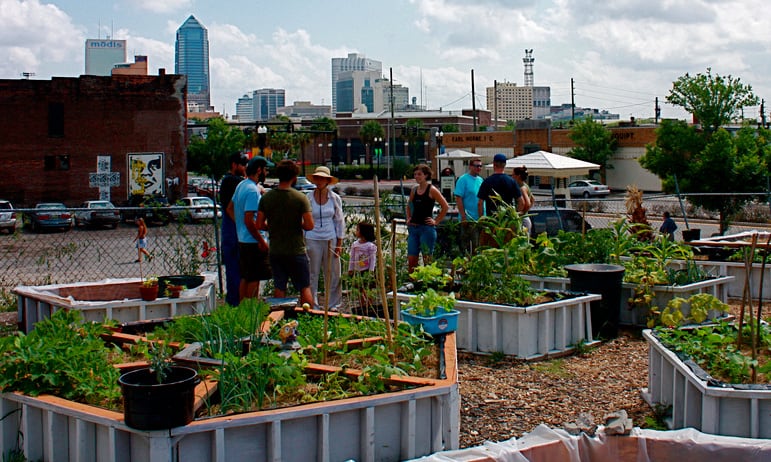Little Known Facts About City Blooming.
Little Known Facts About City Blooming.
Blog Article
Top Guidelines Of City Blooming
Table of ContentsCity Blooming Fundamentals ExplainedThe Ultimate Guide To City BloomingAll About City BloomingOur City Blooming IdeasNot known Factual Statements About City Blooming
Intrigued in expanding food for sale in the City of Chicago? Below is a listing of regularly asked questions concerning the guidelines and regulations that cultivators must think about when planning a city agriculture project.
The zoning change does not modify any kind of various other codes taking care of composting, structure authorizations, purchasing or renting City possessed property, company licenses or environmental contamination. There are existing codes that regulate these problems and they stay in complete result and may be applicable to your project. Community gardens are commonly owned or taken care of by public entities, civic organizations or community-based organizations and maintained by volunteers.
Urban ranches expand food that is intended to be marketed, either on a not-for-profit or for-profit basis. Due to their business function, city ranches call for a company certificate. Yes. A neighborhood yard is enabled to offer excess create that was grown on site if the sales are accessory or secondary to the yard's key purpose defined above.
The smart Trick of City Blooming That Nobody is Talking About
Composting is enabled but only for plant product that is produced and utilized on website. The quantity of compost product can not go beyond 25 cubic backyards at any kind of offered time according to the criteria in 7-28-715 of the City's Municipal Code. Yes. Due to the fact that the soil at many new yard sites needs amending, garden compost, soil, wood chips, or other materials can be gotten to create or improve the expanding space - sustainability.

If a structure authorization is required after that the hoophouse will be considered an accessory building. You can figure out more concerning the structure permit demands by calling the Division of Buildings. The 25,000-square-foot dimension limit is intended to prevent a single area garden from controling a given block or diminishing the block's existing household or business character.
The limitation does not apply to yards found in Public Open Room (POS) districts. Can there be even more than one area yard that is 25,000 square feet on a solitary block? Yes. The dimension limit relates to private gardens, not to individual blocks. No. Secure fencing is not needed, nonetheless, yards that have large car park locations might be called for to install secure fencing or various other landscaping features.
See This Report about City Blooming
B1 & B2 districts call for that all business use tasks be performed indoors. Is fencing required for urban farms? Fencings might be needed, along with landscaping and testing, for particular car park locations and outside job or storage locations depending on area and the certain activity taking area.
Yes. Urban farms need building permits and zoning approvals before building and construction. Various other forms of city evaluation may be required depending upon certain structures, activities, size, landscape design, licensing, public health and stormwater administration issues. Much of these requirements are identified in the task layout or allowing process, nevertheless, the applicant might be accountable to independently recognize particular licenses or allows that may be called for.
Yes. The sort of permit is figured out by what is occurring at the site. The Division of Service Matters and Consumer Security can help determine the particular type of organization certificate that's required. Yes. Off road car parking is needed for most commercial tasks in Chicago. The required variety of garage is based upon the number of workers working with website and not the square video of the growing room.
How City Blooming can Save You Time, Stress, and Money.

Yes. An urban ranch can market garden compost product generated on website, nevertheless, the procedure has to abide with the policies in 7-28-715 of the Chicago Municipal Code. Yes. Aquaponic systems are my response enabled inside on city ranches in lots of zoning districts. However, a zoning evaluation and building authorization is required in order to mount frameworks or systems and an organization certificate is needed as described above.
As much as five hives or nests of honey bees might be maintained as an accessory use. Nonetheless, beekeepers must sign up with the Illinois Division of Agriculture. For even more info concerning the recommended zoning change you may get in touch with the Division of Housing and Economic Development, Bureau of Preparation and Zoning at 312.744.8563.
, which takes location in rural locations at the edge of residential areas.
What Does City Blooming Mean?
It can include a motion of natural cultivators, "foodies" and "locavores", who look for to form socials media based on a common principles of nature and neighborhood holism. These networks can develop by way of formal institutional support, ending up being incorporated into local community preparation as a "transition town" motion for sustainable urban development.
In either instance, the extra direct access to fresh veggie, fruit, and meat items that might be realised through urban agriculture can improve food security and food safety and security while reducing food miles, bring about lower greenhouse gas discharges, therefore contributing to climate adjustment mitigation. A few of the first evidence of city farming originates from Mesopotamia.
Report this page